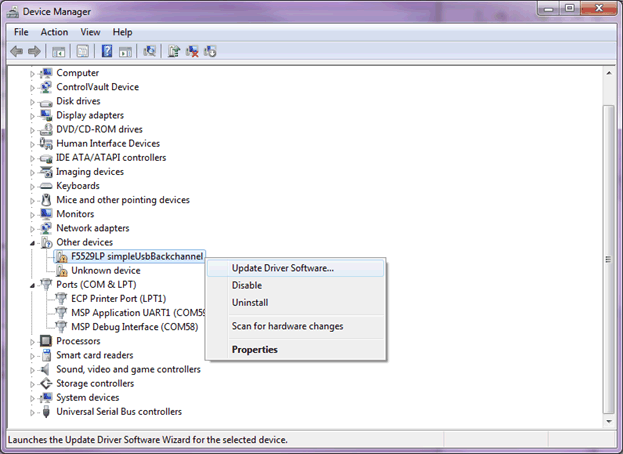SLAU533D September 2013 – April 2017
-
MSP430F5529 LaunchPad™ Development Kit (MSP‑EXP430F5529LP)
- Trademarks
- 1 Getting Started
- 2
Hardware
- 2.1 Block Diagram
- 2.2
Hardware Features
- 2.2.1 MSP430F5529
- 2.2.2 eZ-FET lite Onboard Emulator
- 2.2.3 Integrated Full-Speed USB Hub
- 2.2.4 Power
- 2.2.5 Clocking
- 2.2.6 Application (or "Backchannel") UART
- 2.2.7 Emulator and Target Isolation Jumper Block
- 2.2.8 Isolation Jumper Block: 3.3-V and 5-V Jumpers
- 2.2.9 Isolation Jumper Block: Emulator Connection and Application UART
- 2.3 Measure Current Draw of MSP430 MCU
- 2.4 Using an External Power Source
- 2.5 Using the eZ-FET lite Emulator With a Different Target
- 2.6 USB BSL Button
- 2.7 BoosterPack Plug-in Module Pinout
- 2.8 Design Files
- 2.9 Hardware Change Log
- 3
Software Examples
- 3.1 MSP430 Software Libraries: driverlib and the USB API
- 3.2 Viewing the Code
- 3.3 Example Project Software Organization
- 3.4 USB Configuration Files
- 3.5 Out-of-Box Experience: emulStorageKeyboard
- 3.6 Example: simpleUsbBackchannel
- 3.7 Starting Device Manager
- 4 Additional Resources
- 5 FAQs
- 6 Schematics
- Revision History
3.6.2 Installing the CDC Interface
Now, build and run the example.
When you do this for the first time on a Windows PC, Windows asks for an INF file (simpleUsbBackchannel.inf) to associate with this device. This INF file is located in the simpleUsbBackchannel directory.
Windows XP starts an installation wizard when you attach the device; direct it to this INF file.
Windows 7 does not show a dialog box but, rather, indicates an installation failure in a bubble in the system tray. To install the device, open Device Manager (see Section 3.7). Locate the device (see Figure 32). Right-click on it, and click Update Driver Software.
 Figure 32. simpleUsbBackchannel USB Virtual COM Port, Needing a Driver
Figure 32. simpleUsbBackchannel USB Virtual COM Port, Needing a Driver In the dialog box, browse to the INF file in the simpleUsbBackchannel directory.
If more help is needed to install the CDC interface, see the Examples Guide in the MSP430 USB Developers Package, which contains a more complete description.
Linux PCs do not have this requirement. CDC interfaces enumerate silently as TTY devices in the \dev directory.